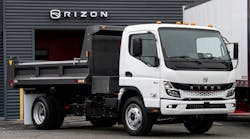While much of the world has embraced natural gas as a fuel for heavy duty trucks, the U.S. has remained skeptics for 15 years, “but those days are over,” according to Dr. Kennon Guglielmo, chief technical officer for a major designer and builder of engine control systems. His company, Econtrols, has already sold NG fuel control systems for over 100,000 trucks, most operating in Asia, and is currently supplying 4,000 a month in that market.
The reasons for that skepticism were good ones, he said at a panel on the future of compressed natural gas (CNG) and liquid natural gas (LNG) as a truck fuel. Lack of a fueling infrastructure, the low power density of NG compared to diesel, the high cost of onboard storage tanks, and little cost difference from equivalent amounts of diesel all argued against NG, according to Guglielmo.
However all that is changing quickly because of a sharp rise in domestic NG supply. “Shale natural gas is a game changer,” Guglielmo said. For decades oil and gas prices rose and fell in parallel, but in 2005 “gas and oil prices decoupled” as oil rose sharply and NG began falling, he said. As production of NG from shale fields began to increase in 2007, NG prices started dropping even more sharply and by 2009 the cost of NG was one-eighth of an equivelant amount of oil, he said.
Because of the abundant shale field reserves, NG prices should continue to remain low even as use increases, while diesel prices are expected to continue to escalate, according to Guglielmo. The large economic advantage is leading to a rapid expansion of fueling options and concentrated technical development of higher performing NG truck engines and lower-cost vehicle storage tanks, removing the barriers to much broader NG use by U.S. fleets, he said.
Daimler Truck North America, which already has 1,500 NG trucks operating in fleets, expects CNG and LNG to account for 20% of the U.S. truck market by 2020, according to Robert Carrick, NG sales manager for the company.
The lower and less volatile fuel costs are the prime driver of that switch, along with development of more dependable engine technology, availability of production line NG trucks, and fueling infrastructure growth, he said during the panel.
While NG “is not for everyone,” DTNA believes the 20% forecast by 2020 “is quite attainable,” Carrick said.
From a fleet perspective, equipment prices will have to come down to make NG practical for long haul tractor applications, according to Dan England, chairman of C.R. England. His fleet is currently running five LNG tractors in a dedicated 500 mi. roundtrip operation.
LNG systems added $80,000 to the cost of each tractor, according to England. On top of that, maintenance costs are running 0.11/mi., compared to $0.7/mi. for the fleet’s diesel-powered tractors.
By England’s calculation, diesel would have to reach $4.85/gal. to reach break even with the NG tractors. However the introduction next year of new, less expensive NG engines for HD applications would reduce that break even to around $4.15/gal., he said.
Both Guglielmo and Carrick pointed out that the lack of a diesel particulate filter (DPF) on new NG HD engines will over the longer term bring NG maintenance cost close to, if not at parity with diesel engines. Volume production of the new NG engines as well as the vehicle storage tanks should also reduce the initial cost penalty substantially, Guglielmo said.
Despite the high cost of the fleet's initial NG trucks, England said that he expects “to see a good percentage of our fleet running on LNG within five years.”


